Upon our arrival in Mumbai, India, we were immediately whisked away to the airport where we began what Silversea referred to as their Mid Voyage Land Adventure, highlights of which included visits to two UNESCO World Heritage Sites, the Agra Fort and the majestic Taj Mahal. This involved an excursion of four days/three nights, an Air India flight to Delhi, overnight stays in the posh Oberoi New Delhi & Oberoi Amarvilas hotels, and return flight to Cochin where we would once again reboard our cruise ship.
Gurdwara Sri Bangla Sahib, Delhi, India: One of the most prominent Sikh gurdwaras, Sikh house of worship, in Delhi. Situated near 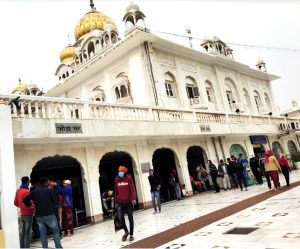 Connaught Place, it is instantly recognizable by its distinctive golden dome.
Connaught Place, it is instantly recognizable by its distinctive golden dome.
The grounds include the Gurdwara, a kitchen, a large holy pond, a school, and an art gallery. As with all Sikh Gurdwaras, the concept of langar is practiced. All people, regardless of race or religion may eat in the Gurdwara kitchen. The food is prepared by gursikhs who work there and also by volunteers.
When entering the temple, visitors are requested to cover their hair and remove their shoes. Head scarves and shoe-minding service can be found inside the compound and are available free of charge.
Agra, India: Agra is a city on the banks of the Yamuna River in the Indian state of Uttar Pradesh. It 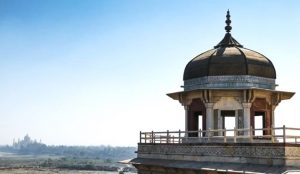 is located 140 miles south-east of Delhi, the national capital. With a population of roughly 1.6 million, Agra is the fourth-most populous city in Uttar Pradesh and the twenty-third most populous city in India.
is located 140 miles south-east of Delhi, the national capital. With a population of roughly 1.6 million, Agra is the fourth-most populous city in Uttar Pradesh and the twenty-third most populous city in India.
Agra’s notable historical period began during the reign of Sikandar Lodi; however, the golden age of the city began with the Mughals. Babur, who reigned from 1526-30. The founder of the Mughal dynasty, he acquired Agra after defeating the Lodhis and the Tomaras of Gwalior in the first battle of Panipat in 1526. Agra remained the capital of the Mughal Empire until 1658, when Aurangzeb shifted the entire court to Delhi.
Under Mughal rule, Agra became a center for learning, arts, commerce, and religion, and saw the construction of the Agra Fort, the Tomb of 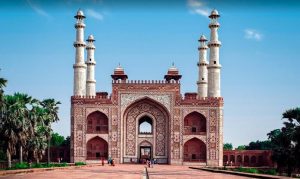 Akbar (pictured: The mausoleum of the third and greatest Mughal emperor Akbar; built in 1605-1613 by his son, Jahangir), and the Taj Mahal, constructed between 1632 and 1648 by Shah Jahan in remembrance of his wife, Mumtaz Mahal.
Akbar (pictured: The mausoleum of the third and greatest Mughal emperor Akbar; built in 1605-1613 by his son, Jahangir), and the Taj Mahal, constructed between 1632 and 1648 by Shah Jahan in remembrance of his wife, Mumtaz Mahal.
With the decline of the Mughal empire in the late 18th century, the city fell successively, first to Marathas and later to the East India Company. After independence, Agra developed into a manufacturing center with a booming tourism industry. It is now included on the Golden Triangle Tourist Circuit, along with Delhi and Jaipur.
Agra Fort, Agra, India: The massive 16th-century structure is Agra’s second-most important attraction after the Taj Mahal. The fort’s 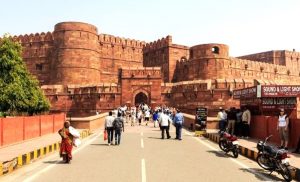 approximately1.5-mile-long red sandstone walls contained the imperial city of the Mughal rulers. Mughal emperor Humayun was crowned here. It was later renovated by the Mughal emperor Akbar from 1565; and the present-day structure was completed in 1573. It served as the main residence of the rulers of the Mughal dynasty until the capital was shifted from Agra to Delhi.
approximately1.5-mile-long red sandstone walls contained the imperial city of the Mughal rulers. Mughal emperor Humayun was crowned here. It was later renovated by the Mughal emperor Akbar from 1565; and the present-day structure was completed in 1573. It served as the main residence of the rulers of the Mughal dynasty until the capital was shifted from Agra to Delhi.
Before being captured by the British, the last Indian rulers to have occupied it were the Marathas. In 1983 the Agra Fort was inscribed as a UNESCO World Heritage Site. A city within a city, it is comprised of fairy-tale palaces, audience halls, and two beautiful mosques.
Taj Mahal, Agra, India: The Taj Mahal (lit. “Crown of the Palace”) is an ivory-white marble mausoleum on the right bank of the Yamuna River. 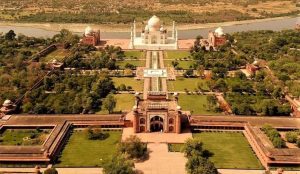 It was commissioned in 1631 by Shah Jahan, the fifth Mughal emperor (r. 1628-1658) to house the tomb of his favorite wife, Mumtaz Mahal, who died on June 17th of that year, giving birth to their 14th child. It also houses the tomb of Shah Jahan himself. The tomb is the centerpiece of a 42-acre complex, which includes a mosque, a guest house, and is set in formal gardens enclosed on three sides by a crenellated wall (a wall containing battlements).
It was commissioned in 1631 by Shah Jahan, the fifth Mughal emperor (r. 1628-1658) to house the tomb of his favorite wife, Mumtaz Mahal, who died on June 17th of that year, giving birth to their 14th child. It also houses the tomb of Shah Jahan himself. The tomb is the centerpiece of a 42-acre complex, which includes a mosque, a guest house, and is set in formal gardens enclosed on three sides by a crenellated wall (a wall containing battlements).
The Taj Mahal was constructed using materials from all over India and Asia. It is believed that over 1000 elephants were used to transport building materials. Some 22,000 laborers, painters, embroidery 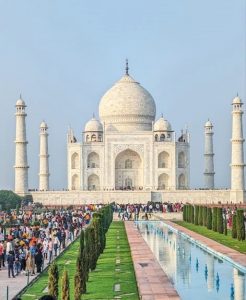 artists and stonecutters were used. The translucent white marble was brought from Makrana, Rajasthan; the jasper from the Punjab region; jade & crystal from China. The turquoise was from Tibet, the lapis lazuli (a deep blue metamorphic rock used as a semi-precious stone) from Afghanistan, the sapphire from Sri Lanka, and the carnelian from Arabia. In all, 28 types of precious and semi-precious stones were inlaid into the white marble.
artists and stonecutters were used. The translucent white marble was brought from Makrana, Rajasthan; the jasper from the Punjab region; jade & crystal from China. The turquoise was from Tibet, the lapis lazuli (a deep blue metamorphic rock used as a semi-precious stone) from Afghanistan, the sapphire from Sri Lanka, and the carnelian from Arabia. In all, 28 types of precious and semi-precious stones were inlaid into the white marble.
Construction of the mausoleum was essentially completed in 1643, but work continued on other phases of the project for another 10 years. It is believed that the Taj Mahal complex was completed in its entirety in 1653 at a cost estimated at the time to be around 32 million rupees, which today would be approximately 70 billion rupees (about 915 million in U.S. dollars).
The Taj Mahal was designated as a UNESCO World Heritage Site in 1983 for being “the jewel of Muslim art 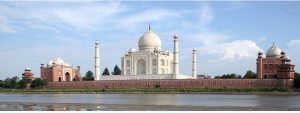 in India and one of the universally admired masterpieces of the world’s heritage.” It is regarded by many as the pinnacle of Mughal architecture. However, due to the global attention that it has received, and the millions of visitors it attracts, the Taj Mahal has become a prominent image that is associated with India… but even more than this, a symbol of India itself, as well as one of the new Seven Wonders of the World (pictured: view of the Taj Mahal and outlying buildings from across the Yamuna River).
in India and one of the universally admired masterpieces of the world’s heritage.” It is regarded by many as the pinnacle of Mughal architecture. However, due to the global attention that it has received, and the millions of visitors it attracts, the Taj Mahal has become a prominent image that is associated with India… but even more than this, a symbol of India itself, as well as one of the new Seven Wonders of the World (pictured: view of the Taj Mahal and outlying buildings from across the Yamuna River).
All that being said, however… as I quickly discovered, the more one learns about the Taj Mahal, the more one realizes there is so much more one does not know. Scholarly articles and essays abound…ditto myths, legends, deep dark mysterious secrets, and a superfluous sprinkling of crackpot theorists. And sometimes it is difficult – if not downright impossible – to separate fact from fantasy.
For example, the most famous myth – undoubtedly false – describes in rather horrific detail the mutilations and dismemberments that were inflicted upon those associated with the construction of the tomb. In order to ensure that no one could recreate the beauty of the Taj Mahal, Shah Jahan supposedly severed the hands and gouged out the eyes of the artisans and craftsmen. Despite the prevalence of this rather gruesome tale, historians have found absolutely no evidence to support the story.
Another longstanding myth – and certainly one of the most fascinating – holds that Shah Jahan planned another mausoleum to be built in black marble across the Yamuna River. The story had its roots in the fanciful writings of Jean-Baptiste Tavernier, a European traveler who visited Agra in 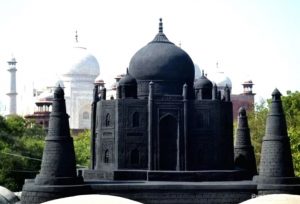 1665. He maintained that Shah Jahan had begun the construction of his own tomb on the opposite side of the river, but that Jahan’s son, Aurangzeb, overthrew him before the Black Taj Mahal could be built. Local legends also add that Shah Jahan intended to connect the two tombs with a bridge across the Yamuna River, possibly made of silver.
1665. He maintained that Shah Jahan had begun the construction of his own tomb on the opposite side of the river, but that Jahan’s son, Aurangzeb, overthrew him before the Black Taj Mahal could be built. Local legends also add that Shah Jahan intended to connect the two tombs with a bridge across the Yamuna River, possibly made of silver.
Research has shown that Shah Jahan asked his architects to modify the Mahtab Bagh (Moonlight Garden) built by his great-grandfather emperor Babar, to incorporate it within the Taj Mahal complex. It has been suggested that this was to be the site of the second Taj. It has also been pointed out that while the Taj Mahal was built in perfect symmetry, Shah Jahan’s cenotaph (a monument to someone buried elsewhere… more on that below) appears to be the exception. It is irregularly positioned in the burial chamber, while Mumtaz Mahal’s cenotaph lies at the center. It is also much larger in comparison to Mumtaz Mahal’s and almost appears to be an afterthought. Is it possible that Shah Jahan never intended to be buried along with his wife?
The evidence noted above may seem perfectly plausible… However, historians have dismissed the idea of a second Taj because, except for Tavernier, there is no reference to it in the other contemporary accounts of the time. Archaeological excavations of the area have also not found any trace of the construction of such a building. And while ruins of black marble were found in the Mahtab Bagh, further research led to the conclusion that they were white stones that had discolored over the years.
Whether the story is fact or fiction is, to me at least, a moot point. Having personally visited the Taj Mahal, I can assure you that the mere mental image of two such magnificent structures facing each other on either side of the Yamuna River is enough to set fire to anyone’s imagination.
On the other hand, the fact that the architects and craftsmen of the Taj Mahal were masters of proportion and optical illusion is beyond question. When one first approaches the main gate that frames the Taj, for example, the monument appears incredibly large and close… but as one gets closer, it shrinks in size – exactly the opposite of what one would expect. In addition, although the minarets surrounding the tomb appear to be perfectly straight and upright, in reality, they actually lean outward, serving both form and function. Not only do these pillars provide an aesthetic balance, but they would also crumble away from the main crypt in the case of a natural disaster such as an earthquake.
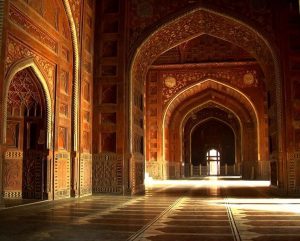 As awe-inspiring as the exterior may be, the interior ornamentation is equally impressive. As you enter, you observe a large octagonal-shaped structure with a dome at the top. The interiors are stunning, amazingly beautiful, yet beguilingly subtle. The basic elements of the structure are Persian. The floor is vast, echoing the slightest sound, while a series of breath-taking arches are embellished with exquisite calligraphy.
As awe-inspiring as the exterior may be, the interior ornamentation is equally impressive. As you enter, you observe a large octagonal-shaped structure with a dome at the top. The interiors are stunning, amazingly beautiful, yet beguilingly subtle. The basic elements of the structure are Persian. The floor is vast, echoing the slightest sound, while a series of breath-taking arches are embellished with exquisite calligraphy.
The main chamber, the tomb, is the central focus of the entire complex of the Taj Mahal. The tomb is an octagonal shaped room that was built in such a way that any face can be used as an entry, although only the south garden face is used. The walls are 25 meters high (approximately 82 feet). They contain 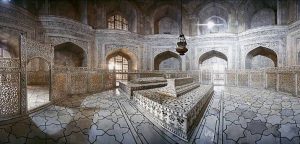 eight arches, four on the lower portion of the walls, four on the upper. The four top arches form balconies – viewing areas – each containing a jali or screening carved from marble in the shape of vines, fruits, and flowers.
eight arches, four on the lower portion of the walls, four on the upper. The four top arches form balconies – viewing areas – each containing a jali or screening carved from marble in the shape of vines, fruits, and flowers.
Since Muslim tradition does not permit the elaborate decoration of graves, what visitors see, therefore, are cenotaphs. That is, monuments to those buried elsewhere. In this instance, the bodies of Shah Jahan and Mumtaj Mahal were laid to rest in a relatively plain crypt just below the main chamber, which is inaccessible to the public.
One final word… If you plan to visit the Taj Mahal – which should definitely be on your bucket list – be sure to leave plenty of time, as the Taj is a creature of many moods. In the morning light, it is white as the driven snow; in the evening, it takes on a golden hue; and in the moonlight, it is irresistibly romantic.
Old Delhi, India: We began with a brief visit to the Jama Masjid Mosque, one of the largest in India. Built by Mughal emperor Shah Jahan 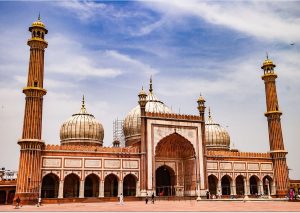 between 1650 and 1656, it was constructed by approximately 5,000 workers. The workforce was diverse, consisting of Indians, Arabs, Persians, Turks, and Europeans. The project was supervised by Sadullah Khan, the wazir (prime minister) during Shah Jahan’s reign, and Fazil Khan, the comptroller of Shah Jahan’s household. The cost of the construction at the time was one million rupees. The mosque was inaugurated on July 23, 1656, by Syed Abdul Ghafoor Shah Bukhari from Bukhara, Uzbekistan, who had been invited by Shah Jahan to be the Shahi Imam (Royal Imam) of the mosque. The Jama Masjid was one of the last monuments built under Shah Jahan. After it’s completion, it served as the royal mosque of the emperors until the end of the Mughal period.
between 1650 and 1656, it was constructed by approximately 5,000 workers. The workforce was diverse, consisting of Indians, Arabs, Persians, Turks, and Europeans. The project was supervised by Sadullah Khan, the wazir (prime minister) during Shah Jahan’s reign, and Fazil Khan, the comptroller of Shah Jahan’s household. The cost of the construction at the time was one million rupees. The mosque was inaugurated on July 23, 1656, by Syed Abdul Ghafoor Shah Bukhari from Bukhara, Uzbekistan, who had been invited by Shah Jahan to be the Shahi Imam (Royal Imam) of the mosque. The Jama Masjid was one of the last monuments built under Shah Jahan. After it’s completion, it served as the royal mosque of the emperors until the end of the Mughal period.
Leaving the mosque, we set out, via bicycle rickshaw, to explore the sights and sounds of Old Delhi. 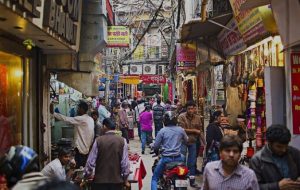 This is what is commonly called the Chandni ‘Chowk, historic buildings that were once home to prominent families of days-gone-by. Today, however, this district is one of the country’s best-known wholesale markets for textiles, electronic goods, and watches. Its narrow, winding side streets are also home to shops overflowing with spices, jewelry, books, hardware, brilliantly-dyed fabrics, and vendors hawking a variety of foods prepared on the spot… Awash with tsunamis of bustling humanity, the crowded streets conjured up nightmarish visions described in the oft-quoted opening sentences of American biologist Paul Ehrlich’s The Population Bomb (see photograph).
This is what is commonly called the Chandni ‘Chowk, historic buildings that were once home to prominent families of days-gone-by. Today, however, this district is one of the country’s best-known wholesale markets for textiles, electronic goods, and watches. Its narrow, winding side streets are also home to shops overflowing with spices, jewelry, books, hardware, brilliantly-dyed fabrics, and vendors hawking a variety of foods prepared on the spot… Awash with tsunamis of bustling humanity, the crowded streets conjured up nightmarish visions described in the oft-quoted opening sentences of American biologist Paul Ehrlich’s The Population Bomb (see photograph).
Bon Appétit & Cheers!
TAD

{ 0 comments… add one now }